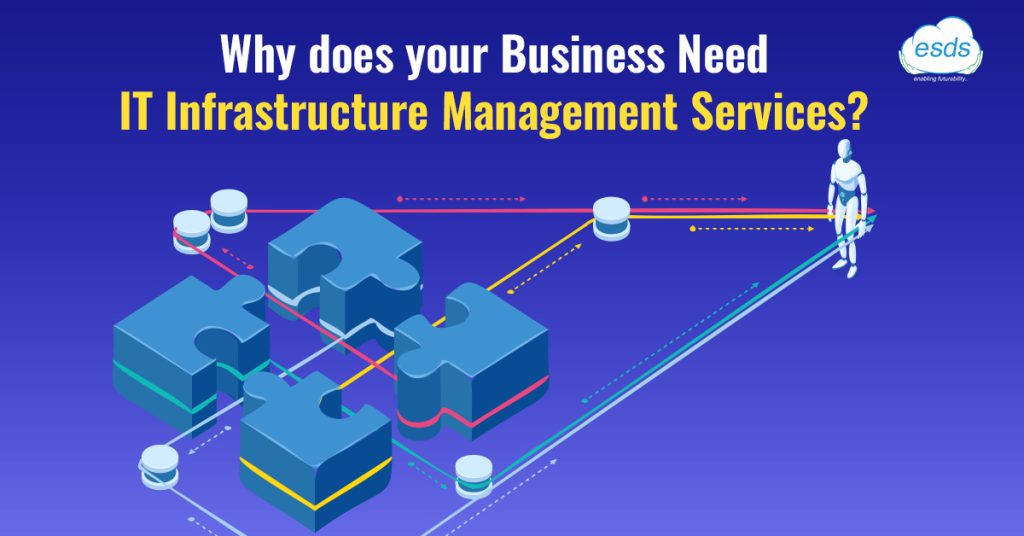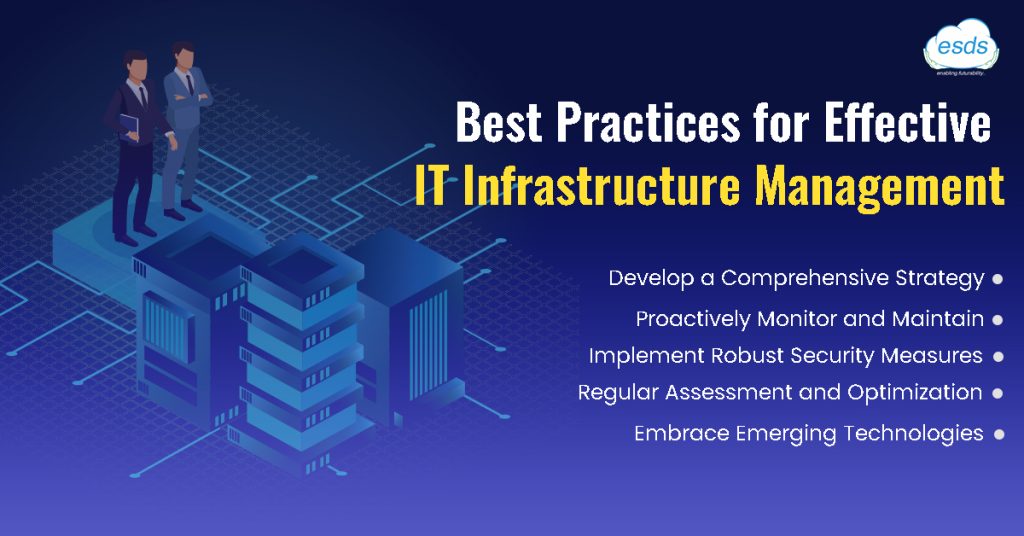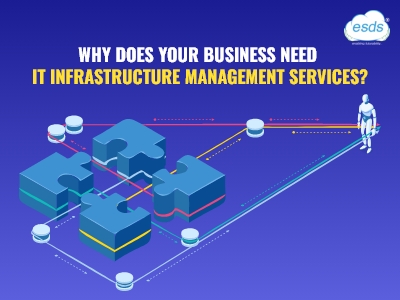Why does your Business Need IT Infrastructure Management Services?

Technology drives businesses’ operations, and to stay competitive, the effective management of IT infrastructure is crucial. From ensuring seamless day-to-day operations to safeguarding sensitive data against cyber threats, IT infrastructure management services are the backbone of modern enterprises.
At its core, IT infrastructure management encompasses overseeing and maintaining various components that constitute an organization’s IT ecosystem. This includes networks, which facilitate communication and data transfer; servers, which host applications and store data; data storage systems, which house critical information; and security systems, which protect against unauthorized access and malicious activities. Common challenges in IT infrastructure management include ensuring the reliability and availability of services, scaling resources to meet growing demands, and fortifying defenses against cyber threats while managing costs effectively.
Key Services Offered in IT Infrastructure Management:
1. Network Management and Monitoring: This involves continuous monitoring of network infrastructure to detect and address performance bottlenecks, connectivity issues, and security breaches in real time, ensuring optimal network performance and uptime.
2. Server Management and Optimization: Proactive maintenance and optimization of server infrastructure to maximize resource utilization, improve application performance, and minimize downtime, thereby enhancing overall reliability and efficiency.
3. Data Backup and Disaster Recovery: Reliable disaster recovery plans should be implemented to reduce the danger of data loss from hardware malfunctions, natural catastrophes, or cyberattacks. This will ensure reduced downtime and business continuity.
4. Security Management and Threat Prevention: Implement comprehensive security measures, including firewalls, intrusion detection systems, encryption, and access controls, to defend against several kinds of cyber security risks, including malware, phishing scams, ransomware, and data breaches, to secure sensitive information and uphold a company’s brand.
5. Cloud Infrastructure Management: Management of cloud-based resources and services, including provisioning, monitoring, optimization, and governance, to ensure scalability, flexibility, and cost-effectiveness while meeting business requirements and regulatory compliance.
6. IT Asset Lifecycle Management: Comprehensive management of IT assets throughout their lifecycle, from procurement to disposal, including inventory management, asset tracking, maintenance, and retirement, to optimize asset utilization, minimize costs, and mitigate risks associated with hardware and software obsolescence.
Benefits of Outsourcing IT Infrastructure Management:
Outsourcing IT infrastructure management offers several compelling benefits for businesses:
Cost Savings: By outsourcing IT infrastructure management to specialized service providers, businesses can reduce operational costs associated with hiring and maintaining in-house IT teams and overhead expenses related to infrastructure maintenance, upgrades, and compliance.
Access to Expertise: Businesses may use the most recent technology and industry best practices to promote innovation and accomplish strategic goals by outsourcing to a broad pool of competent individuals with specific knowledge and expertise in managing complex IT systems.
Enhanced Security: Professional IT infrastructure management services offer advanced security solutions and proactive monitoring capabilities to detect and mitigate cyber threats before they can cause harm, thereby reducing the risk of data breaches, financial losses, and reputational damage.
Scalability: Outsourced IT infrastructure management services can scale dynamically to accommodate changing business requirements, seasonal fluctuations in demand, and unexpected growth, providing businesses the flexibility and agility to stay competitive in today’s fast-paced digital landscape.
Best Practices for Effective IT Infrastructure Management:

To ensure effective IT infrastructure management, businesses should adhere to the following best practices:
Develop a Comprehensive Strategy: Define clear goals, objectives, and performance metrics for IT infrastructure management, aligning them with business priorities and strategic initiatives to drive value and achieve desired outcomes.
Proactively Monitor and Maintain: Implement robust monitoring tools and proactive maintenance routines to continuously monitor the health, performance, and security of IT infrastructure components, identifying and solving potential issues before they escalate into costly disruptions or security incidents.
Implement Robust Security Measures: Adopt a multi-layered approach to cybersecurity, combining preventive, detective, and corrective controls to protect against threats and vulnerabilities, including malware, phishing attacks, insider threats, and zero-day exploits.
Regular Assessment and Optimization: Conduct regular assessments and performance audits of IT infrastructure components to identify areas for improvement, optimize resource utilization, and fine-tune configurations to align with evolving business needs and industry best practices.
Embrace Emerging Technologies: Stay updated about emerging technologies, trends, and innovations in IT infrastructure management, such as cloud computing, artificial intelligence, automation, and DevOps, to capitalize on new opportunities, drive efficiency gains, and remain competitive in the marketplace.
Here are some real-life examples of successful IT infrastructure management implementations By ESDS Software Solution:
Case Study 1: A National-level council for technical education, under the Department of Higher Education, established in November 1945 first as an advisory body and later in 1987 given statutory status by an Act of Parliament which is today supporting & controlling over 22 Lacs+ Technical Students seats in India. Network monitoring and reports were their biggest challenge, and the need to secure digital information by promoting quality and cost-effective technologies for sustainable development was on their agenda. Managing switch configuration from the monitoring portal effectively was something they were looking for [Read More]
Case Study 2: ESDS Team identified the problem areas of the apex body and was able to provide the right 0 solution. A full-fledged eNlight 360 software with a hybrid Orchestration layer and unified monitoring gave them complete visibility of their IT infra [Read more]
Conclusion:
The effective management of IT infrastructure is paramount for organizations striving to operate efficiently, securely, and competitively in today’s digital economy. Enter eNlight 360 which is an One stop solution for all IT Infrastructure Management issues and elevate your operations, mitigate risks, and propel your IT infrastructure towards achieving your goals in the digital age. Unlock a myriad of benefits including cost savings, heightened security measures, access to specialized expertise, scalability, and agility. This empowers organizations to redirect their focus towards core business activities and strategic growth initiatives. Reach out to us today and discover more about eNlight 360.
- Strengthening BFSI Security Posture with SOAR Integration - June 27, 2025
- Security Operations Center (SOC) Services: A Measured Approach to Digital Threat Management - April 11, 2025
- The Impact of AI on Colocation Services - February 13, 2025
